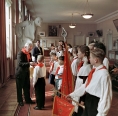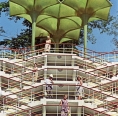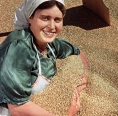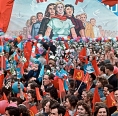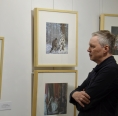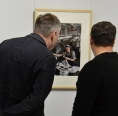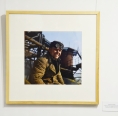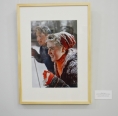-

“OGONYOK. LIFE AS A HOLIDAY”
-
Address:
-
Partners:
An exhibition “Life as a Holiday”, which consists of archival photos published in “Ogonyok” magazine in the period between the 1930s and 1970s will be open from May 22 until July 14 in the Magnezit Museum and from May 23 until July 14 in Magnezit Cultural Center. The exhibition is provided by the Multimedia Art Museum, Moscow.
Since its foundation in 1899, “Ogonyok” made its name as an illustrated magazine: it became the television for the pre-TV epoch, which gathered all family members together. After a pause taken during the revolutionary years and revival in 1923, by 1925 “Ogonyok” has already been published as an edition of 500,000 copies.
This period is a real photo clamor for the country: a photo becomes a powerful visual weapon of the young Soviet regime. The best Soviet masters in photography worked for “Ogonyok”. Photos made by Arkady Shaikhet, Yeleazar Langman, Emmanuil Yevzerikhin, Vsevolod Tarasevich, Issak Tunkel, Mikhail Savin, Eduard Ettinger, Galina Sanko, Dmitry Debabov, Semyon Fridlyand, Lev Borodulin, Lev Sherstennikov and, of course, Dmitry Baltermantz were published on its pages. The latter started working for “Ogonyok” in 1946, and then for a quarter-century, from 1965 until 1990, he headed the photography division of the magazine.
The tradition of the “Ogonyok” photos has been formed in many of its aspects by the history and ideology of the country. A photo is a mirror of our time, but an amalgam of that mirror is determined by the time and changes as it passes. Starting from the 1930s, photography, together with all other types of art, was to follow the principles of social realism. The photographer did not have a task to take a photo “as is”, but “as it was to be”. Photo guides of that period paid special attention to positioning and directing rules, which were to be applied to a seemingly objective photo reportage. Each directed photo becomes a political statement, being both a product and an ideological activity tool at the same time. Using the power of their talent, photographers construct an image of the happiest man in the happiest country. Collective labor feats in fields, plants and construction sites, images of the new reality of everyday life, scenes from a worry-free childhood and well-deserved rest — everything in these photos published in the magazine is filled with the atmosphere of holiday or its anticipation. Together they form a mythological weave of collective happiness.
Its visual canon was finally established by the middle of the 1950s — the flushing time for “Ogonyok” as a photo-illustrated magazine. This is the period, when photos from its cover pages and centerfolds furnish the walls in city apartments, workers’ cabins, soldiers’ barracks, out-patient clinics and cultural centers. This particular time became the “main character” of the exhibition. In the thawing 1960s, an individual happiness starts glimpsing through the veil of the collective holiday — face expressions, plastics, plots and tones of photos start changing. In the 1970s, as the stagnation period comes, a holiday gradually ceases to be the main topic for the Soviet photo art. Therefore, the photos made during these two decades do not take the main places at the exhibition, but draw a line and shade in the aesthetics and the ideological direction of the previous epoch.
The photos made by the Soviet photographers included into the exposition, dazzle us and — as the years go by — at the same time make us think about our past, present and future. “Ogonyok” today is a part of the new media space: reality looks at us from its pages, and it witnesses not only holidays. But one thing remains unchanged — the place occupied by “Ogonyok” in the life of the vast country and in the history of the Russian journalism.
The exhibition is provided by the Multimedia Art Museum, Moscow.
The Multimedia Art Museum, Moscow (МАММ) / the Moscow House of Photography was founded by the Government of Moscow in 1996. It is the first museum of photography and multimedia in Russia. Its director is Olga Sviblova. The collection of the museum contains more than 180,000 depository items. The museum does not show any constant exposition: exhibitions come and go. МАММ represents projects made by the stars in the world and Russian photography and modern art, works done by young artists, as well as video art pieces, VR, performances and art pieces comprising new technologies. Within a year МАММ holds about 60 exhibitions. In addition, the museum provides educational programs in arts for children and adults. Famous artists and photographers give lectures and master-classes in МАММ. Such programs as MAMMcinema, MAMMmusic, MAMMdiscussion are organized in the museum on a regular basis.
Photo by: Anna Filippova.
-
26.08 - 26.08
DIARY OF THE THIRD INDUSTRIAL BIENNALE
-
28.11 - 28.11
MY SATKA FESTIVAL WINS THE CONTEST OF CORPORATE VOLUNTEER PROJECTS
-
13.10 - 15.10
COOPERATION WITH VGIBL NAMED AFTER M.I. RUDOMINO

